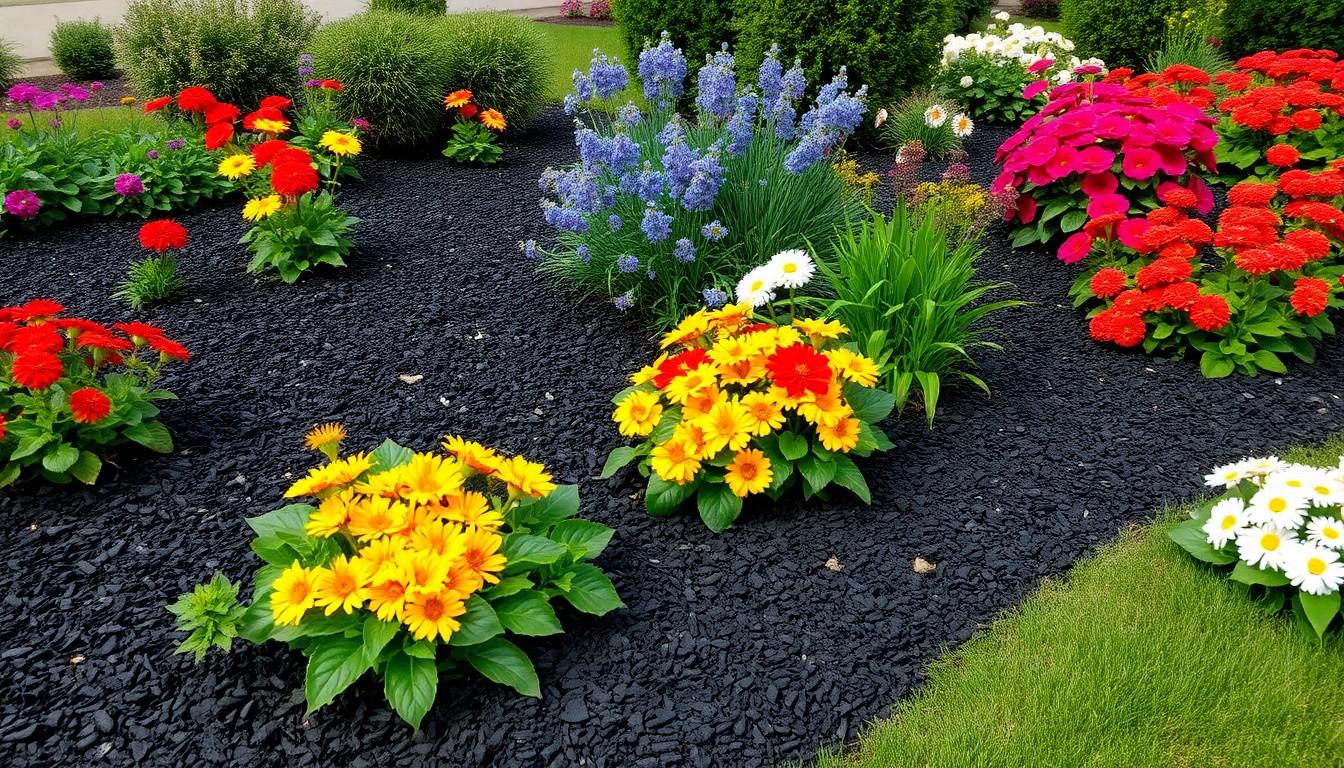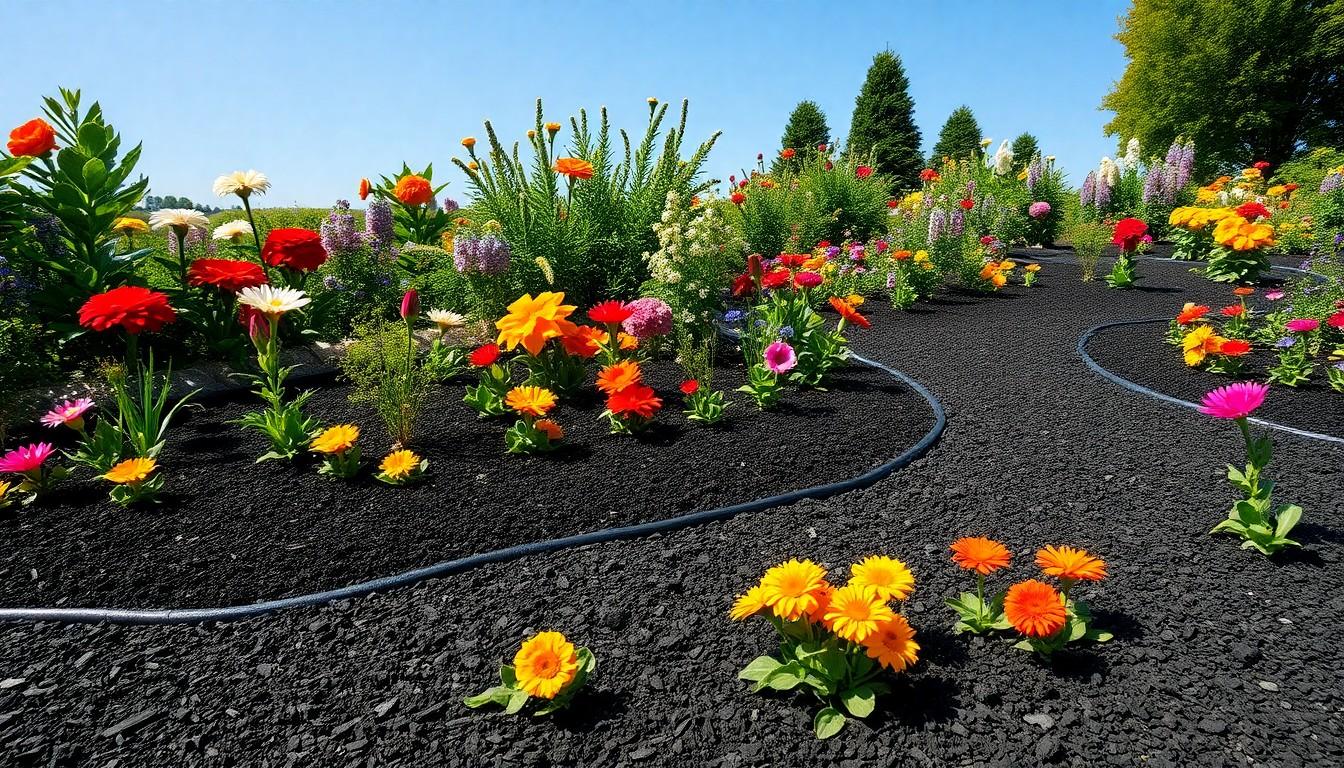In the world of landscaping, black mulch is like the little black dress—timeless, versatile, and always in style. Modern black mulch landscaping has taken center stage, turning ordinary gardens into chic outdoor spaces that even your neighbor’s prize-winning roses would envy. It’s not just about looks; black mulch offers practical benefits too, like moisture retention and weed prevention. Who knew that a simple layer of mulch could be the superhero your garden never knew it needed?
Imagine transforming your yard into a stunning oasis where every flower and shrub shines against a sleek black backdrop. With its striking contrast and contemporary vibe, black mulch is the secret ingredient to creating an eye-catching landscape. Get ready to dig deeper into the wonders of modern black mulch landscaping and discover how it can elevate your outdoor aesthetic while keeping your garden low-maintenance and fabulous.
Overview Of Modern Black Mulch Landscaping
Modern black mulch landscaping significantly improves outdoor spaces. This landscaping choice enhances visual aesthetics through its rich, dark color, which provides striking contrasts against vibrant plants and flowers. Furthermore, black mulch effectively retains soil moisture, benefiting plant growth and reducing the need for frequent watering. It contributes to weed prevention, acting as a barrier that discourages the growth of unwanted plants, thus promoting a low-maintenance garden.
Utilizing black mulch creates a clean, polished look across various landscapes. Homeowners increasingly favor this option for both residential and commercial properties due to its versatility. Options range from rubber mulch to dyed wood products, each offering distinct benefits. Rubber mulch, for example, is durable and long-lasting, while dyed wood mulch provides natural aesthetics.
Modern black mulch also aligns well with eco-friendly gardening practices. Organic materials can decompose and enrich the soil, adding nutrients over time. Gardeners appreciate how black mulch can contribute to improved soil quality while maintaining an attractive appearance.
Incorporating black mulch into a yard doesn’t just elevate the design; it enhances functionality. Borders and pathways made with black mulch can guide visitors and create structure in garden layouts. With the right implementation, this mulch can transform any ordinary garden into an eye-catching landscape.
Overall, modern black mulch landscaping presents a practical solution for beauty and low upkeep. Its advantages underscore its growing appeal among those looking to refine their outdoor environments.
Benefits Of Using Black Mulch

Black mulch offers multiple advantages for landscaping, making it a popular choice among homeowners and designers. Its rich color enhances the overall aesthetics of outdoor spaces.
Aesthetic Appeal
Visual interest shifts dramatically when black mulch is used. Dark mulch provides striking contrast against vibrant plants and flowers, creating an eye-catching landscape. This color enhances the natural beauty of gardens, allowing flora to stand out. Additionally, black mulch complements various design styles, from modern to traditional. Its sleek appearance contributes to a polished and finished look. Maintenance remains minimal as the color doesn’t wash away with rain, ensuring lasting visual appeal.
Soil Temperature Regulation
Soil temperature benefits significantly from black mulch usage. The dark color absorbs heat from sunlight, warming the soil during cooler months. Plants thrive with a consistent temperature, as nutrient absorption increases. In hotter weather, black mulch retains moisture, preventing the soil from overheating. These qualities promote a healthy growing environment, enhancing plant growth and productivity. Mulch also acts as insulation, protecting roots from temperature fluctuations.
Weed Control
Weed suppression improves when using black mulch in gardens. A thick layer effectively blocks sunlight, inhibiting weed germination and growth. As a result, less manual weeding occurs, saving time and effort. The barrier prevents weeds from competing with desired plants for nutrients and water. This control contributes to a more organized and tidy garden appearance. Additionally, black mulch breaks down over time, enriching the soil and supporting plant health.
Types Of Black Mulch
Various types of black mulch enhance landscaping and gardening. Each type offers distinct advantages suited to different needs.
Organic Black Mulch
Organic black mulch consists of natural materials like wood chips, bark, and compost. This type decomposes over time, enriching the soil while providing nutrients for plants. It effectively retains moisture, reduces soil erosion, and promotes healthy root growth. Additionally, organic mulches can improve soil structure, enhancing air and water cycles. The earthy aesthetics of this mulch type harmonize well with garden designs, creating a natural look. Popular choices include cedar, pine, and hardwood chips, each offering unique texture and longevity.
Inorganic Black Mulch
Inorganic black mulch includes materials such as rubber or stone. This type doesn’t decompose, so it requires less frequent replacement, making it a low-maintenance option. It effectively suppresses weeds while allowing water to penetrate the soil. Rubber mulch, often made from recycled tires, provides excellent drainage and a long lifespan. Gravel or black landscape fabric can also serve as effective barriers against weeds. The modern appearance of inorganic mulches suits contemporary landscaping designs while maintaining durability against the elements.
Application Techniques
Black mulch application techniques ensure optimal benefits for garden aesthetics and plant health. Following specific methods enhances the effectiveness of black mulch in landscaping.
Preparation Of The Area
Clearing the area before applying mulch is essential. Removing debris, weeds, and previous mulch promotes better soil contact. Raking the soil facilitates an even surface that allows for proper drainage and moisture retention. Amending the soil with organic matter can improve its fertility, providing a richer environment for plants. Using a landscaping fabric may also be beneficial, as it acts as an additional barrier against weeds while allowing water to penetrate.
Proper Mulching Depth
Maintaining the correct mulching depth is critical for maximizing benefits. A depth of 2 to 4 inches generally provides effective weed control and moisture retention. Placing too much mulch can suffocate plants, while too little won’t suppress weeds effectively. Even distribution across the area promotes healthy airflow and correct water movement. Observing the growth of plants can help determine if adjustments are necessary, ensuring the garden receives optimal nutrition and protection.
Maintenance Tips For Longevity
Proper maintenance preserves the longevity of black mulch landscaping. Regular inspection of mulch levels ensures adequate coverage. Adding new layers of black mulch every year or two maintains its aesthetic appeal and effectiveness.
Moisture retention in black mulch is critical. Watering less frequently helps prevent mulch from breaking down too quickly. During dry periods, a thorough watering helps sustain moisture levels in the soil.
Weed control requires vigilance. Pulling out any weeds as soon as they appear minimizes competition for nutrients. Maintaining a gap between plants and mulch reduces the chance of weeds taking root.
Fungal development can occur if moisture levels are too high. Avoid overwatering to prevent fungal issues. Using a balanced fertilizer supports plant health and encourages mulch to degrade naturally over time without excessive moisture buildup.
Protecting mulch from excessive compaction is essential. Avoid walking on mulch areas to keep it fluffy and effective. Using a mulch border can also help define spaces, preventing soil compaction around plant bases.
Seasonal adjustments to mulch depth optimize its benefits. Checking depth after heavy rain or wind ensures it remains within the recommended 2 to 4 inches. Performing this task in spring prepares the garden for growth while addressing any displacement caused by elements.
Lastly, monitoring for color fading is important. Reapplying colored mulch maintains the rich, dark aesthetic. It enhances visual appeal and complements vibrant plants, ensuring the landscape remains stunning throughout the seasons.
Conclusion
Embracing modern black mulch landscaping offers a blend of beauty and practicality. Its striking appearance not only enhances garden aesthetics but also supports plant health through effective moisture retention and weed suppression. The versatility of black mulch options caters to various design preferences and maintenance needs, making it an ideal choice for both homeowners and commercial properties.
By implementing proper application techniques and maintenance practices, one can ensure a vibrant and sustainable outdoor space. As the popularity of black mulch continues to rise, it stands out as a smart investment for those looking to elevate their landscaping while enjoying the benefits of a low-maintenance garden.

